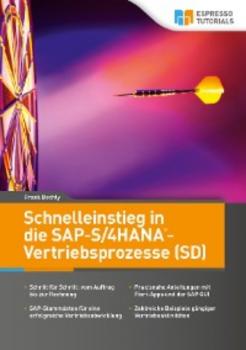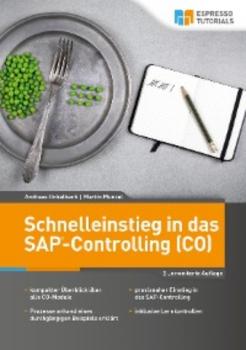ТОП просматриваемых книг сайта:















Программы
Различные книги в жанре Программы, доступные для чтения и скачиванияАннотация
Mit SAP BW/4HANA wurde das klassische Business Warehouse für die Analyse historischer Daten um die Auswertung von Echtzeitdaten erweitert. In diesem Buch werden Sie praxisnah und mit vielen Screenshots Schritt für Schritt durch diese aktuelle Data-Warehouse-Anwendung der SAP geführt. Zur Lösung eines Fallbeispiels aus der Versorgungsbranche erstellt der Autor ein Datenmodell in einem SAP-BW/4HANA-System. Im Zuge dessen wird eine Reihe von Objekten für die benötigten Stamm- und Bewegungsdaten angelegt: Datenflussdiagramme, DataSources, InfoSources, die fundamental wichtigen InfoObjects und Transformationen, um die angeforderten Auswertungen und Berichte erstellen zu können. Darüber hinaus beschreibt er das Laden der Daten per Datentransferprozess ins SAP-BW/4HANA-System sowie deren Auswertung im CompositeProvider.In vielen Übungsaufgaben werden Sie ermutigt, das gezeigte Vorgehen selbstständig umzusetzen. Dazu erhalten Sie eine kurze Einführung in die Entwicklungsumgebung Eclipse sowie in die BW Modeling Tools. Ein Ausblick auf aktuell geplante Erweiterungen, insbesondere in Richtung SAP Data Warehouse Cloud, runden das Werk ab.– Grundlagen von Business Intelligence – Einführung in die Datenmodellierung mit Eclipse – Datenflüsse der Stamm- und Bewegungsdaten- Demonstration an einem durchgängigen Fallbeispiel
Аннотация
The cognitive approach to the IoT provides connectivity to everyone and everything since IoT connected devices are known to increase rapidly. When the IoT is integrated with cognitive technology, performance is improved, and smart intelligence is obtained. Discussed in this book are different types of datasets with structured content based on cognitive systems. The IoT gathers the information from the real time datasets through the internet, where the IoT network connects with multiple devices. This book mainly concentrates on providing the best solutions to existing real-time issues in the cognitive domain. Healthcare-based, cloud-based and smart transportation-based applications in the cognitive domain are addressed. The data integrity and security aspects of the cognitive computing main are also thoroughly discussed along with validated results.
Аннотация
When considering the idea of using machine learning in healthcare, it is a Herculean task to present the entire gamut of information in the field of intelligent systems. It is, therefore the objective of this book to keep the presentation narrow and intensive. This approach is distinct from others in that it presents detailed computer simulations for all models presented with explanations of the program code. It includes unique and distinctive chapters on disease diagnosis, telemedicine, medical imaging, smart health monitoring, social media healthcare, and machine learning for COVID-19. These chapters help develop a clear understanding of the working of an algorithm while strengthening logical thinking. In this environment, answering a single question may require accessing several data sources and calling on sophisticated analysis tools. While data integration is a dynamic research area in the database community, the specific needs of research have led to the development of numerous middleware systems that provide seamless data access in a result-driven environment. Since this book is intended to be useful to a wide audience, students, researchers and scientists from both academia and industry may all benefit from this material. It contains a comprehensive description of issues for healthcare data management and an overview of existing systems, making it appropriate for introductory and instructional purposes. Prerequisites are minimal; the readers are expected to have basic knowledge of machine learning. This book is divided into 22 real-time innovative chapters which provide a variety of application examples in different domains. These chapters illustrate why traditional approaches often fail to meet customers’ needs. The presented approaches provide a comprehensive overview of current technology. Each of these chapters, which are written by the main inventors of the presented systems, specifies requirements and provides a description of both the chosen approach and its implementation. Because of the self-contained nature of these chapters, they may be read in any order. Each of the chapters use various technical terms which involve expertise in machine learning and computer science.
Аннотация
A good management strategy must be expected to mitigate the dangerous consequences of rapid urbanization that modern society, the economy, and the environment may face. Sustainable smart cities include established structures, infrastructures, communities, institutions, and individuals. On the other hand, this book also deals with energy consumption. Such energy consumption leads to a rapid depletion of energy resources, an increased need for building maintenance, an improvised comfortable lifestyle, and an increase in time spent on building construction. A sustainable building mainly explains the renewable sources used for construction, which helps the structure withstand atmospheric changes. Currently, all countries are looking for ecological materials, that is, renewable plant materials such as straw and clay bricks, wood from forests certified for sustainable management, recycled materials, and other non-toxic, reusable and renewable products. For sustainable and durable construction, energy efficiency is an urgent problem, and researchers are currently actively involved in this area. This book will provide an in-depth analysis of design technologies that lay a solid foundation for sustainable buildings. The book also highlights smart automation technologies that help save energy, as well as various performance indicators needed to make construction easier. The book aims to create a strong research community, to have a deep understanding and the latest knowledge in the field of energy and comfort, to offer solid ideas in the nearby future for sustainable and resilient buildings. These buildings will help the city grow as a smart city. The smart city has also focused on low energy consumption, renewable energy, and small carbon footprints. To find the optimal use of energy resources, researchers must study optimization methods.
Аннотация
This book – the first of two volumes – explores the syntactical constructs of the most common programming languages, and sheds a mathematical light on their semantics, while also providing an accurate presentation of the material aspects that interfere with coding. <p><i>Concepts and Semantics of Programming Languages 1</i> is dedicated to functional and imperative features. Included is the formal study of the semantics of typing and execution; their acquisition is facilitated by implementation into OCaml and Python, as well as by worked examples. Data representation is considered in detail: endianness, pointers, memory management, union types and pattern-matching, etc., with examples in OCaml, C and C++. The second volume introduces a specific model for studying modular and object features and uses this model to present Ada and OCaml modules, and subsequently Java, C++, OCaml and Python classes and objects. <p>This book is intended not only for computer science students and teachers but also seasoned programmers, who will find a guide to reading reference manuals and the foundations of program verification.
Аннотация
The 24 chapters in this book provides a deep overview of robotics and the application of AI and IoT in robotics. It contains the exploration of AI and IoT based intelligent automation in robotics. The various algorithms and frameworks for robotics based on AI and IoT are presented, analyzed, and discussed. This book also provides insights on application of robotics in education, healthcare, defense and many other fields which utilize IoT and AI. It also introduces the idea of smart cities using robotics.
Аннотация
A comprehensive review of the key emerging technologies that will directly impact areas of computer technology over the next five years Infrastructure edge computing is the model of data center and network infrastructure deployment which distributes a large number of physically small data centers around an area to deliver better performance and to enable new economical applications. It is vital for those operating at business or technical levels to be positioned to capitalize on the changes that will occur as a result of infrastructure edge computing. Understanding Infrastructure Edge Computing provides a thorough understanding of the growth of internet infrastructure from its inception to the emergence of infrastructure edge computing. Author Alex Marcham, an acknowledged leader in the field who coined the term infrastructure edge computing presents an accessible, accurate, and expansive view of the next generation of internet infrastructure. The book features illustrative examples of 5G mobile cellular networks, city-scale AI systems, self-driving cars, drones, industrial robots, and more—technologies that increase efficiency, save time and money, and improve safety. Covering state-of-the-art topics, this timely and authoritative book: Presents a clear and accurate survey of the key emerging technologies that will impact data centers, 5G networks, artificial intelligence and cyber-physical systems, and other areas of computer technology Explores how and why Internet infrastructure has evolved to where it stands today and where it needs to be in the near future Covers a wide range of topics including distributed application workload operation, infrastructure and application security, and related technologies such as multi-access edge computing (MEC) and fog computing Provides numerous use cases and examples of real-world applications which depend upon underlying edge infrastructure Written for Information technology practitioners, computer technology practitioners, and students, Understanding Infrastructure Edge Computing is essential reading for those looking to benefit from the coming changes in computer technology in the near future.
Аннотация
Mit diesem Anwenderhandbuch können Mitarbeiter und Neueinsteiger im Vertrieb die grundlegenden Abläufe und Prozesse im Modul SD mit SAP S/4HANA leicht nachvollziehen. Alle zentralen Vorgänge werden sowohl in der SAP-GUI- als auch in der Fiori-Oberfläche betrachtet. Sie starten mit der Definition der Standardprozesse im SAP-System: von der Erfassung des Vertriebsauftrags, über die Angebotserstellung und Lieferung bis hin zur Fakturierung erhalten Sie detaillierte Einblicke. In diesem Zusammenhang werfen Sie auch einen Blick auf die Pflege der Stammdaten und darauf, welche Bedeutung hier einzelne Felder für die Vertriebsabwicklung haben. Darüber hinaus lernen Sie, Arbeitsvorräte als Basis für die Sammelverarbeitung der Vielzahl von Belegen im Vertriebsprozess anzulegen und wie Sie Retourenprozesse mithilfe der SAP-Software abbilden oder Gutschriften und Ersatzlieferungen behandeln. Für die Analyse von Umsätzen, Kunden, Materialien etc. werden Ihnen die mit S/4HANA neu erschienenen Embedded Analytics für Auswertungen in Echtzeit vorgestellt; diese ergänzen die klassischen Listen und Reports. Abschließend beschreibt der Autor, wie sich der Vertriebsprozess in die Logistik einfügt und welche Optionen der Anwender zur Steuerung und Kontrolle der Finanzbuchhaltung hat. Schritt für Schritt: vom Auftrag bis zur Rechnung SAP-Stammdaten für eine erfolgreiche Vertriebsabwicklung Praxisnahe Anleitungen mit Fiori-Apps und der SAP GUI Zahlreiche Beispiele gängiger Vertriebsaktivitäten
Аннотация
Dieser kompakte und anschauliche Leitfaden führt Sie in die Grundlagen des SAP-Controllings (CO) ein. Das Buch richtet sich gleichermaßen an Einsteiger wie auch an SAP-Anwender, die sich einen schnellen Überblick über die Anwendungsmöglichkeiten der Komponente SAP CO verschaffen wollen, um alltägliche Anforderungen mit der SAP-Software umzusetzen. Sie lernen die CO-Objekte »Kostenstelle« und „Auftrag« näher kennen, erfahren Grundlegendes zur Mitbuchtechnik zwischen Finanzbuchhaltung (FI) und Controlling (CO) und wie Sie eine „innerbetriebliche Leistungsverrechnung“ bzw. „kennzahlenbasierte Verrechnung“ für einen Betriebsabrechnungsbogen (BAB) anwenden. Anhand praxisnaher Beispiele und Screenshots vermitteln Ihnen die erfahrenen Buchautoren die wichtigsten SAP-Controlling-Funktionen für den Lebenslauf eines Produkts: von der Kalkulation bis hin zur Fertigung sowie der anschließenden Umsatz- bzw. Absatzauswertung inklusive Deckungsbeitragsrechnung. Zur persönlichen Lernkontrolle sind jedem Kapitel Fragen zum Verständnis beigefügt.
– kompakter Überblick über alle CO-Module – Prozesse anhand eines durchgängigen Beispiels erklärt – praxisnaher Einstieg in das SAP-Controlling – inklusive Lernkontrollen
– kompakter Überblick über alle CO-Module – Prozesse anhand eines durchgängigen Beispiels erklärt – praxisnaher Einstieg in das SAP-Controlling – inklusive Lernkontrollen










